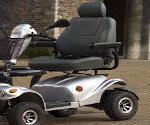Low-battery anxiety is a real thing. It’s defined as the ‘fear of running out of battery when driving an electric vehicle’. Since our society has come to depend on batteries more and more, this anxiety makes sense.
Our phones, cars, and of course, mobility scooters, all rely on batteries. Oftentimes these tools provide functions we can’t live without.
But this can mean that our range of movement extends only as far as the next available charger. What if there were a way to get a longer range out of your mobility scooter?
Read on and we’ll tell you how you can get the most out of your mobility scooter.

Battery Care for Longer Range
Aside from reading your mobility scooters manual, to get the most out of it look no further than the battery. Taking good care of your battery is easy. A few simple steps can protect your investment and your mobility.
All mobility scooter and electric wheelchair batteries are 12-volts. They are usually fitted in pairs to produce 24-volt output. While they all are the same voltage there are a few different types of batteries we’ll go over now.
Mobility Scooter Battery Types
So, we know that the battery pack consists of two, 12-volt batteries. They are also sealed acid batteries. Batteries of the past required maintenance. Getting topped-off with battery acid as needed.
Today, all modern scooter batteries are maintenance-free. The three most common are as follows.
Absorbed Glass Mat Batteries (AGM) are the most common. These are a bit cheaper upfront compared to other batteries. They have a quick charge time but produce fewer use cycles overall.
Gel Batteries are longer-lasting batteries and cost a bit more because of it. There is no liquid so the battery can be moved about freely, and they don’t produce any fumes. Gel batteries great for mobility scooters that are used indoors and frequently.
Lithium Batteries are not as common but are quickly gaining in popularity. They have a few stand-out qualities. They are light, have a short charge time, and can last two to four times longer than the other batteries.
No matter which type of battery you choose for your scooter, make sure that both batteries are the same type. You can’t mix gel and lithium, or AGM and gel. Both batteries must be the same or you could risk damaging your scooter or harming yourself.
Now that we’ve covered the types of batteries let’s talk about charging them.
How to Make Your Battery Last Longer
There are a few simple steps you can take to ensure your mobility scooter’s battery longevity. If you follow all our guidelines you may be able to get a longer range and longer life out of them.
Charging a mobility scooter battery
Proper charging practices can help to extend the life of your scooter battery. There are two stages in the charging process. The first covers the bulk of the charge, while the second is more of a low-powered, trickle-charge.
Both are important. Once the battery is fully charged, a trickle-charge will begin to condition your battery. This conditioning step is critical to achieving high-performance.
Mobility Scooter – Infographic

How often should you charge mobility scooter batteries?
A good rule of thumb is to charge your scooter after each use. We also recommend setting your scooter to charge overnight. Where possible, try not to let your batteries drain completely.
If your batteries are brand new there is a break-in cycle. The batteries should be kept fully charged, and first time should be an 18-hour charge. Try to only drain them 30% for the first week, or when the indicator goes from green to yellow plug it in.
Expect to complete 15 to 20 charging cycles before your batteries reach their full capacity.
Storage
The life-span of your battery is heavily impacted by how you store it. Better storage practices mean you get a longer range.
Temperature extremes in either direction are bad for your battery. Try to store your scooter somewhere that won’t get too hot or too cold.
If you won’t be using your scooter for a period, disconnect the batteries. Ideally, keep the batteries fully charged when storing. That way you are ready to take off when you go to use it again.
If a battery has reached freezing temperatures, make sure to let it return to room temp. Then you can start your scooter.
Many battery packs are removable and can charge indoors. Best case scenario you store your scooter indoors. If you can’t, indoor charging and storage of your batteries is the next best thing.
Other Ways To Make Your Battery Last Longer
A few other best practices to extend your range and increase battery capacity are:
- Try to keep the weight-load minimal. The more weight on your scooter the harder it is on the battery.
- Keep a steady pace and avoid a lot of stop-and-go driving.
- Make sure the battery has a full charge before you leave home.
- Keep the tires filled with the right level of air.
- Try to keep your drives on a level road as much as possible.
- Only use the charger provided with the batteries.
- Keep a fully-charged, spare battery pack on deck for emergencies.
Battery Capacity and Replacement
All batteries will have different capacities. This is measured in amp-hours and lets you know how much energy your battery can hold. In general, the greater the amp-hours the further your scooter can go.
Mobility scooters are often limited to a certain size battery. This means that the kind of scooter you have may limit the capacity it can reach. This is something to consider when selecting both scooters and batteries.
Most batteries on the market today will last for two to three years. Doubly so if you follow our guidelines. The more wear and tear on the battery the more impact on its life-span.
How Do I Know When to Replace?
There are many warning signs that you need new batteries. Like a rapid decline in power once you turn on the scooter, and loss of power or speed ability even with a full charge. Keep an eye out for any changes in performance as these are the first clues batteries are failing.
When you find you need to replace your batteries you may be able to swap them for ones that are better suited to your scooter use. If you went with the AGM batteries and they didn’t quite do it, you can upgrade. Gel and lithium batteries are compatible with most new models.
How to Pick the Best Scooter and Battery for You
Unlike their counterpart, the powered wheelchair, mobility scooters can handle indoor and outdoor terrain. A good rule of thumb is to think about where your scooter will take you before investing in one.
If you plan to spend most of your time indoors, you can get a nice indoor mobility scooter. If you want the freedom to go from inside to outside there are mobility scooters that may be better for you.
Identifying how you plan to use your scooter can help you make an informed battery choice as well. For short, indoor distances you may be able to get away with the more affordable AGM batteries. If you plan to go long distances you may be better served by gel batteries.
Best Outdoor Mobility Scooter
There are quite a few excellent outdoor only mobility scooters. Great for people who want to remain active who would otherwise be limited.
One of our favorites is the Merits Silverado Extreme Bariatric Scooter. If you are looking for a long-range ride that’s sleek and stylish, look no further.
The standard battery it comes with gives you 37.5 miles on a full charge. You can even upgrade batteries for 55 miles. You won’t crush any speed challenges with this one. But you can tackle terrain other mobility scooters normally can’t touch.
Best Indoor-Outdoor Mobility Scooter
If you need mobility help with your day-to-day, an indoor-outdoor model may be the best choice for you.
There are so many options here too, but our top choice is the Drive Medical Phoenix 4HD Heavy Duty.
The tires won’t mark up indoor flooring, and they offer tip protection. Great for when you encounter rockier terrain. A full charge will take you 15 miles.
Easily go from the grocery store to the hiking trail with this one, it’s a great all-around kind of scooter.
Care for Your Scooter and It Will Care for You
There are many great reasons to get a mobility scooter. Whether you have decreased mobility in general, or you are recovering from an injury. A scooter is a great investment to make as we age.
And now you know just how easy it is to take care of.
If you follow our guidelines you can rest easy. You’ll enjoy full battery power and longer range, well through the warranty stage. Say good-bye to low-battery-anxiety and hello to your next adventure.
If you liked this guide, make sure to ‘favorite’ our website and come back often. We do all the research so you don’t have to! Check out our other guides and resources for more tips, tricks, and recommendations.












